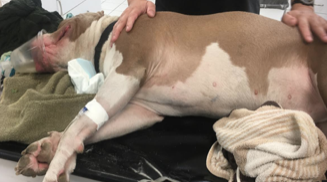Heat Stroke in Dogs
Written by Natalie Allen, 3rd year veterinary student • 2019 Scholar
History and Physical Exam
Titan is a 7 year old pit bull who presented to IVS unresponsive after being on a run. The patient was in lateral recumbency with an initial temperature of 108.4. Upon physical exam, Titan had hyperthermia, tachycardia (abnormally high heart rate), tachypnea (Increase respiratory rate), as well as petechiation (pinpoint bruising) on his gums and ventral midline. The patient also vomited and had bloody diarrhea, which later became frank blood.




